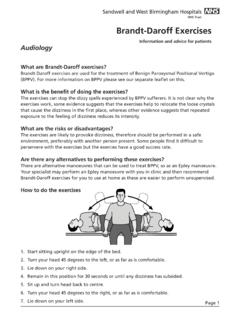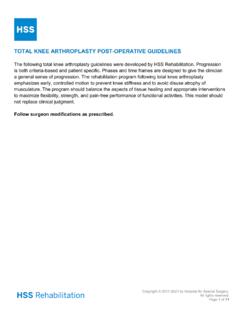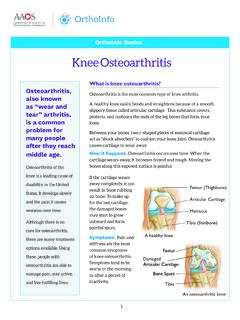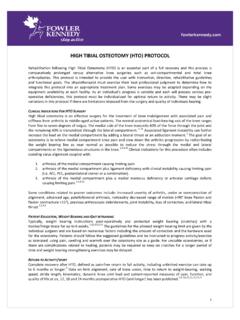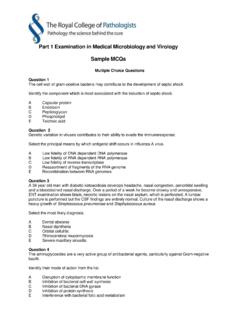Transcription of NHS Trust Exercises following total hip replacement
1 Sandwell and West BirminghamNHS TrustExercises following total hip replacementInformation and advice for patients following a total hip replacementPhysiotherapy DepartmentPage 1In order to get the best outcome following your total hip replacement it is important that you follow the advice and exercise programme given to you by a member of the therapy therapist will help you with your Exercises and mobility but it is your responsibility to continue with them independently while in hospital and at are the benefits of the Exercises ?These Exercises will help you improve and maintain good muscle strength and movement. They will help reduce pain after your operation and reduce post-operative complications. In order to get the best result from your total hip replacement you will need to be committed to doing your are the risks of the Exercises ?
2 There are no risks to performing the Exercises but you may feel slight discomfort in your hip whilst performing them; this is normal. What are the risks of not doing the Exercises ?If you do not perform the Exercises regularly, you may experience stiffness and loss of movement in your hip. You may also not see any improvement in hip pain or function after the operation. Are there any alternatives to these Exercises ?There are no alternatives to these Exercises that will help you maintain good muscle strength, movement and help you regain function in your operated to perform the exercisesTry to repeat each exercise 10 times every hour for the first 2 weeks and then 3 times a day for the following 6 Pumps1. This can be performed in a chair or Move your foot up and down as far as it will go.
3 3. This will help to improve your circulation. 2020, Sandwell & West Birmingham NHS and West BirminghamNHS TrustExercises following total hip replacementInformation and advice for patients following a total hip replacementPhysiotherapy DepartmentStatic Gluteuls Static QuadricepsHip Abduction in LyingHip Flexion in LyingHip Flexion in standing Page 21. Sitting or lying, squeeze your buttocks2. Hold this for 5-10 seconds3. Relax1. Sit or lie with your operated leg Tighten your thigh muscle and push your knee into the bed. 3. Hold this for 5-10 seconds4. Relax1. In lying with your operated leg out straight. 2. Move the operated leg out to the side as far as possible. 3. Return to starting position. DO NOT cross In lying with your operated leg straight to start.
4 2. Bend your knee by sliding your foot towards your bottom- do not bend past 90 degrees. 1. In standing with your back Lift your operated leg, bending your knee as you do do not go past 90 degrees. 3. Slowly lower leg down back to resting position. Sandwell and West BirminghamNHS TrustExercises following total hip replacementInformation and advice for patients following a total hip replacementPhysiotherapy DepartmentHip Abduction in standing Hip Extension in standing Stairs AdviceGoing Up1. Non-operated leg2. Operated leg3. Crutch or stickGoing Down1. Crutch or stick2. Operated leg3. Non-operated legHip precautions to follow three months post-op or as per consultant advice; 1. No bending more than 90 degrees at your hip bending forwards or knee above hip 2.
5 No twisting 3. No crossing the legsPage 31. In standing keep your operated leg straight. 2. Move your leg out to the side as far as possible. 3. Slowly return to the starting position. 1. In standing keep your operated leg straight. 2. Keep your back straight during this exercise. 3. Move your operated leg behind you as far as possible. 4. Slowly return to starting position. Sandwell and West BirminghamNHS TrustExercises following total hip replacementInformation and advice for patients following a total hip replacementPhysiotherapy DepartmentLower half dressing advice It is advised that you follow these instructions to assist you in dressing. (This will minimise your risk of a dislocation.) 1. Use your helping hand. 2. Put your operated leg straight out in Always dress your operated leg first, then the non-operated leg.
6 4. Use the helping hand to move your clothes up above your knees. 5. Now stand to pull your clothes up. When removing clothes, take your non-operated leg out first. Use your long handed shoe horn when putting shoes on and off. Bed Transfers Getting out of bed: 1. Lead with your operated Sit up and use your hands to bring your bottom to the edge of the bed. Getting into bed: 1. Lead with non-operated leg. 2. Move your bottom back onto the bed and bring your legs round. Getting in and out of a car1. Ask someone to hold the door open for safety. 2. Have the car seat pushed back as far as possible and reclined. 3. Place one hand on the seat and one on the door frame. 4. Put your operated leg in front of you and lower yourself down.
7 5. Bring your legs into the foot well. 6. Keep your operated leg as straight as possible. Follow-upYou will not routinely have therapy follow up once home. It is your responsibility to continue your Exercises and progress your walking. Page 4ML4689 Issue Date: June 2021 Review Date: June 2024If you would like to suggest any amendments or improvements to this leaflet please contact the communications department on 0121 507 5303 or email: Teaching Trust of The University of BirminghamIncorporating City, Sandwell and Rowley Regis Hospitals Sandwell and West Birmingham Hospitals NHS TrustExercises following total hip replacementInformation and advice for patients following a total hip replacementPhysiotherapy DepartmentSandwell and West BirminghamNHS TrustPage 5(If appropriate) Symptoms to reportYou should expect some swelling , pain and bruising for some weeks after your operation.
8 Taking pain relief, using ice packs as advised and continuing Exercises will help. Go and see you GP if your hip or leg becomes very swollen, red or pain is severeContact detailsYou will see your consultant at six stockings should be worn for six weeks. You should follow your hip precautions for 12 weeks. Gradually increase the distance you walk once informationIf you have any questions or concerns about these Exercises please contact the orthopaedic physiotherapist by telephoning the hospital switchboard and asking the operator to bleep them on bleep WebsiteHip (Website accessed 7 June 2021)Images created and supplied, with permission by the Physiotherapy Department, Sandwell & West Birmingham NHS more information about our hospitals and services please see our website , follow us on Twitter @SWBHnhs and like us on Facebook

